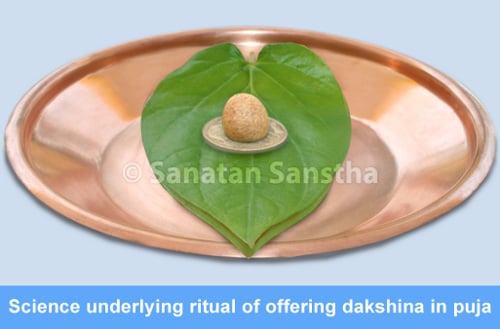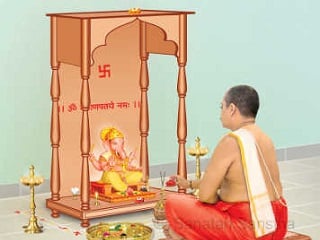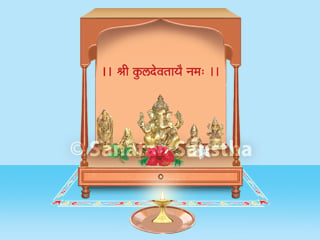Table of Contents
- How to identify pure vermilion?
- What is the significance of rubbing the sandalwood on a stone slate with both hands when the use is for Deities, but with only one hand when the use is for a corpse?
- Why is turmeric and vermilion not added when making gandh?
- Why are only unbroken rice grains used as akshata in ritualistic worship?
- Why is white akshata offered to Lord Satyanarayan and Shiva and usually red akshata (tinted with vermilion) offered to Ganapati and other Deities?
- Why is the tulsī (Holy Basil Leaf) used when offering Naivēdya to God?
- Why is a white betel nut more beneficial than a red one?
- Why is the money in the ritual of offering dakshina, placed on two betel leaves along with betel nut or coconut?
- Why is a banana leaf used to offer naivedya to a Deity?
- What is the Science in offering jaggery and grated coconut to God?
Hindu Dharma provides an opportunity to do spiritual practice to individuals at various spiritual levels. In the initial stages of Spirituality, an individual benefits more by doing ritualistic worship. If the why and how of each aspect of the ritualistic worship is understood, it helps generate bhāv when performing the rituals. This article lists frequently asked questions about ritualistic worship and the spiritual science behind the rituals. Performing rituals with bhāv will help in deriving maximum spiritual benefits of the performed rituals.
1. How to identify pure vermilion?
Constituents of pure vermilion are pure turmeric, diluted lime powder solution made in water and a small quantity of pure camphor. Though other vermilion is made from turmeric, the odour of turmeric is entirely eliminated from it and a Divine scent takes its place. The odour of turmeric is evident only when it is sniffed. In contrast, the scent of pure vermilion is evident from a certain distance. Given ahead are some characteristics of pure vermilion.
-
Pure vermilion has indigenous humidity and yet is completely dry.
-
Its touch is cold like that of ice.
-
Pure vermilion is blood red in colour. It has high iron content.
-
By applying this vermilion on the forehead, negative energies are prevented from entering the body through the midbrow region.
In the past eras [Satyayug (The first in the cycle of four Eras since the origin of the universe), Tretayug (The second in the cycle of four Eras since the origin of the universe) and Dwaparyug (The third Era in the cycle of four Eras since the origin of the universe)] pure vermilion was available. With the passing of the eras the sattva (One of the three components in the universe, signified by purity and knowledge) component in the vermilion has gradually waned. In the current times, pure vermilion is scarcely available.’
(Note: To order pure vermilion, send an e-mail to – [email protected] )
2. What is the significance of preparing the sandalwood paste on a stone slate using both hands for Deities, and using only one hand for a corpse?
A. Preparing sandalwood paste for Deities using both hands
Holding the sandalwood with both hands is indicative of devotion with expectation stemming from duality. When done with both hands the posture activates the Sushumna nadi (The central channel of the spiritual energy flow system, which extends from the base of the spine to the top of the head) that is conducive for spiritual progress. Thus, in spiritual practice according to the Karmakand (Path of Ritualistic worship) importance is given to making gandh with both hands.
B. Preparing sandalwood paste for a corpse using only right hand
When preparing gandh (sandalwood paste) for applying to a corpse, only the right hand should be used. This is because using the right hand to make the paste signifies the act of actually performing a deed with the help of the right channel, that is, Surya nadi (The sun channel), representative of the Energy of action.
Given ahead are spiritual reasons for using only the right hand to make gandh for corpse.
-
Preparing gandh for a corpse is an act of performing the necessary deeds for the subtle body and giving it further momentum with the help of the Energy of action made functional through the right hand.
-
It also means praying for the further momentum of the subtle body aided by the Energy of action of these action frequencies.
-
This posture activates the Surya nadi in the body of the embodied soul preparing the gandh and as a result the raja (One of the three basic components in the universe, signified by activity, passion) frequencies emitted by the gandh enter the corpse.
-
The sub-units of vital energy dormant to some extent in the corpse are thereby activated and thrown out of it or their disintegration to some extent is facilitated. Otherwise negative energies can make use of these sub-units of vital energy dormant to some extent in the corpse and take control of the subtle body.’
3. Why is turmeric and vermilion not added when making gandh?
If turmeric and vermilion are added to the gandh, due to the raja frequencies emitted by the turmeric and vermilion, so also due to the particles of Absolute fire element emitted by the vermilion, the sattva particles in the gandh disintegrate. This destroys its sattva predominance, which means the gandh becomes raja predominant because of turmeric and vermilion. When rubbing sandalwood on a stone slate to make gandh, due to the friction, the movement of raja particles in the turmeric and vermilion gain further momentum and the residual sattva particles in the gandh can undergo disintegration. Hence, turmeric and vermilion should not be added when making gandh.
4. Why are only unbroken rice grains used as akshata (usually smeared with kumkum) in ritualistic worship?
When an object is broken or cut, its ability to attract distressing energies from the Universe is enhanced. It gets loaded with raja-tama (One of the three components in the universe, signified by inertia and ignorance) particles. Consequently, there is a possibility of an embodied soul suffering from distress due to negative energy or a negative energy entering the physical body of the embodied soul. That is why in Hinduism special importance is given to wholeness of objects. Breaking an object signifies a tama attitude. Such an act is forbidden in religious rituals. If instead of unbroken rice grains, broken rice grains are used as akshata their ability to attract the Principles of superior Deities in the Universe is automatically reduced. Consequently, the benefit of the Principles of superior Deities to the worshipper is reduced. Naturally the bestowal of grace and blessings by the Deities on the worshipper is also reduced. Hence, it is appropriate to use akshata of unbroken rice grains in the ritualistic worship.
5. Why is white akshata offered to Lord Satyanarayan and Shiva and usually red akshata (tinted with vermilion) offered to Ganapati and other Deities?
Red akshata represents the manifest, with attributes, destroyer energy of God, while white akshata represents the manifest, attributeless, saviour energy of God.
A. White akshata:
-
White akshata represents extreme detachment, meaning, a symbol of spiritual practice without expectations.
-
Generally white akshata is used to attract frequencies of the main superior Deities, maximally related to the attributeless. These frequencies from the Universe are subtler.
-
Since the Principles of Satyanarayan (Vishnu) and that of Shiva are associated with frequencies of fundamental action and knowledge respectively, white akshata representing worship of the attributeless, are used in their worship.
B. Red akshata:
-
Red akshata represent spiritual practice done with expectations.
-
The Principle of Ganapati or the Goddesses gets attracted to red colour faster than other colours.
-
The akshata tinted with vermilion are subtle.
-
All colour particles have greater ability to attract the ‘with attributes’ frequencies of a Deity. Hence, red akshata are preferred in the worship of Lord Ganapati or Goddess Durga.
6. Why is the tulsī (Holy Basil Leaf) used when offering Naivēdya to God?
A. Offering Naivēdya to a Deity
When tulsī leaves are used for offering Naivēdya to a Deity, it reaches the Deity faster, Naivēdya becomes sāttvik and the possibility of attacks due to negative energies reduces
The tulsī plant has a greater ability to attract sāttviktā from the atmosphere and effectively emit it towards the jīva. It also has a greater ability to attract the Krushṇatattva in the universe.
Benefits
-
By using tulsī leaves for offering Naivēdya, the subtle-waves emitting from the sāttvik food are imbibed by the leaves. Thereafter, by offering the tulsī leaves enriched with the subtle-waves to the Deity, the Deity Principle is easily able to absorb these waves. In this way, the food offered by us easily reaches the Deity through the medium of tulsī leaves and this helps in pleasing the Deity faster.
-
When a tulsī leaf is placed on the Naivēdya, the covering of Raja–Tama particles on it reduces. Due to the sāttvik waves emitting from the tulsī leaves, the environment around the Naivēdya gets purified, and the possibility of attacks by negative energies on the Naivēdya reduces.
-
When a tulsī leaf is placed on the Naivēdya with bhāv, due to its inherent qualities the leaf imbibes the Chaitanya emitting from the Deity and effectively transmits it into the Naivēdya. Consuming such Naivēdya helps the body of the jīva to obtain waves of Chaitanya.’
7. Why is a white betel nut more beneficial than a red one?
White betel nut is raja-sattva predominant, it has the ability to attract superior deities and emit more sattva predominant frequencies and also transform more, the nirgun frequencies into frequencies ‘with sagun’ compared to the red betel nut as the red betel nut is more raja-tama predominant can attract inferior deities.
The white betel nut is conical on top, the subtle air in it is directed upwards, the frequencies emitted from the betel nut are also drawn in the upward direction to a greater extent. This helps in the creation of subtle ceiling of sattva predominant frequencies in the environment. The Cosmic element associated with the subtle particles emerging from the frequencies emitted is Apa-tattva (Absolute Water principle). Due to the emission of the water particles, the atmosphere is cool and the mind feels enthusiastic. As the frequencies are rhythmic and regular, there is consistency in the energy emitted by them. There is increase in the predominance of raja particles in the Pranmaykosh (Vital energy sheath)
The red betel nut is flat on top, the motion of the subtle air in it is downwards, the emitted rays are also drawn in the direction of the patal (Nether region). Thus the effect of the sattva predominant frequencies in the environment lasts for shorter time. The cosmic element being Pruthvi-tattva, the earth particles are gross; the subtle covering created by them on the floor is in the downward direction, due to which there is heaviness in the environment. As the frequencies are irregular, there is no consistency in the energy emitted by them. There is increase in the raja-tama particles in the Pran-deh (Vital body)
The white betel nut is used in all types of ritualistic worship and in auspicious ceremonies to obtain the benefit of the sattva frequencies emitted by the Deities, while the worshippers of the Aghori (An order of mendicants, who roam around with a skull in one hand and burning coals in the other) path use the red betel nut, that attracts and emits raja-tama vibrations to create a model of a person. Then with the help of their knowledge of mantras, they perform rituals on it and fulfill their Energy of Will
It is evident that white betel nut is more sattva predominant and superior when compared to a red betel nut. That is why it is more beneficial to use it in the ritualistic worship.
8. Why is the money in the ritual of offering dakshina (Offering in cash or kind, especially one given to a Brāhmaṇ after a ritual), placed on two betel leaves along with betel nut or coconut?
 The money in the ritual of offering dakshina is never given by itself. It is important to place it along with betel nut or coconut on the betel leaves. In this process, the dakshina functions in the form of Divine energy, whereas the betel nut or coconut functions in the form of Shiva. In a way Shiva-Shakti are offered a place for their mission, that is, in a way a seat is offered to them. The betel leaves are always placed in pairs, because two signifies duality in the mission of Shiva- Shakti. In this way, the worshipper offers a seat to Shiva-Shakti in the form of betel nut or coconut and dakshina on the betel leaves and prays that they function in ‘with attribute’ form.
The money in the ritual of offering dakshina is never given by itself. It is important to place it along with betel nut or coconut on the betel leaves. In this process, the dakshina functions in the form of Divine energy, whereas the betel nut or coconut functions in the form of Shiva. In a way Shiva-Shakti are offered a place for their mission, that is, in a way a seat is offered to them. The betel leaves are always placed in pairs, because two signifies duality in the mission of Shiva- Shakti. In this way, the worshipper offers a seat to Shiva-Shakti in the form of betel nut or coconut and dakshina on the betel leaves and prays that they function in ‘with attribute’ form.
9. Why is a banana leaf used to offer naivedya (Food offered to the Deity as part of ritualistic worship) to a Deity?
The subtle frequencies emitted by colour particles in a banana leaf are associated with the Absolute Water element to a greater extent. The sound generated from the subtle movement of these colour particles is analogous with the subtle sound generated from the ritualistic bell. Because of this subtle sound, the requisite Principles of superior Deities from the Universe associated with the Absolute Ether element are attracted faster into the banana leaf. The colour particles in the banana leaf associated with the Absolute Water element lend momentum to the Principles of the superior Deities. Consequently, the food items offered to the Deity on the banana leaf also receive the superior Principles of the Deities. Consumption of this naivedya purifies the vital energy body and the vital energy sheath simultaneously.
How should the banana leaf (on which the Naivēdya is served) be placed and what is the reason ?
Naivedya is offered to a Deity on a banana leaf. When compared with the stalk of a banana leaf, its tip has greater ability to emit sattvik waves. Sattvik waves emit from the tip of the banana leaf like a fountain. These fountain-like waves help in reducing the proportion of Raja-Tama components in the environment around the individual. Hence, while offering Naivedya to the Deity, the stalk of the leaf on which the Naivedya is served should be towards the Deity and its tip should be towards us.
10. What is the Science in offering jaggery and grated coconut to God?
Jaggery signifies the vital energy and grated coconut signifies the embodied soul, that is, the gross body of the embodied soul. The embodied soul and vital energy is to be offered to God through the medium of jaggery and grated coconut. The vital energy in the form of jaggery is bound by the coating of the grated coconut, that is, the gross body. The vital energy is related to the soul, whereas the embodied soul is related to the physical body. The embodied soul assumes duality through the medium of the vital energy and performs the mission of non-duality. Jaggery is sweet. The embodied soul that has eliminated its ego has the bhav (Spiritual emotion) of sweetness that draws everybody towards it. Thus, the embodied soul easily attains oneness with the comprehensiveness of God. As the mission in non-duality is based entirely on comprehensiveness, there is especial importance of the bhav of sweetness in the form of jaggery. That is why the vital energy also merges into the comprehensive light of God. Offering of jaggery and grated coconut is a symbol of this process. The embodied soul is meant to surrender its body consciousness through the medium of grated coconut and its ego in the form of vital energy through the medium of jaggery and merge into non duality. Hence offering of jaggery and grated coconut is advocated in the ritualistic worship.
Reference : Sanatan Sanstha’s Holy Text on ‘What is the Importance of the Substances used in Ritualistic Worship?‘ and ‘Science underlying worship with five and sixteen substances’






 How to perform Puja Vidhi ?
How to perform Puja Vidhi ? Importance of Puja Samagri in ritualistic worship
Importance of Puja Samagri in ritualistic worship How to arrange the substances in Puja Thali ?
How to arrange the substances in Puja Thali ? How should be the design of Devghar ?
How should be the design of Devghar ? How to arrange the Puja items used in puja ?
How to arrange the Puja items used in puja ? How to arrange Deities in Home temple ?
How to arrange Deities in Home temple ?